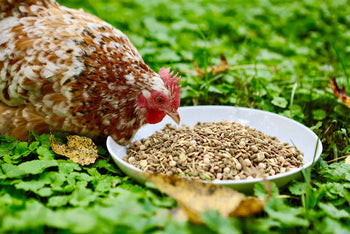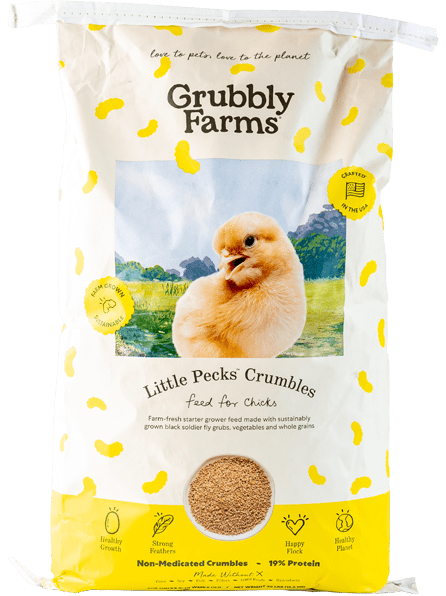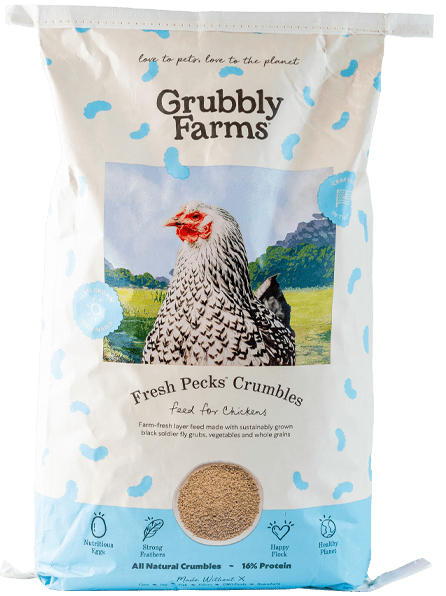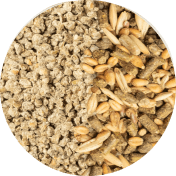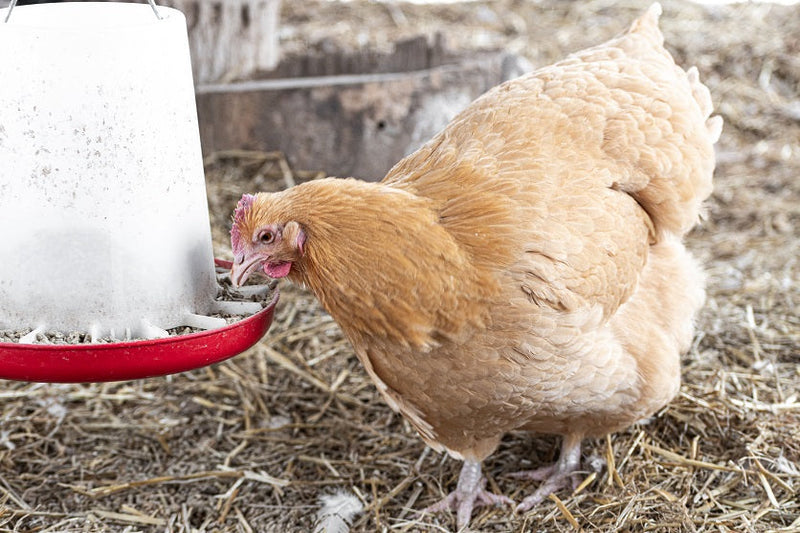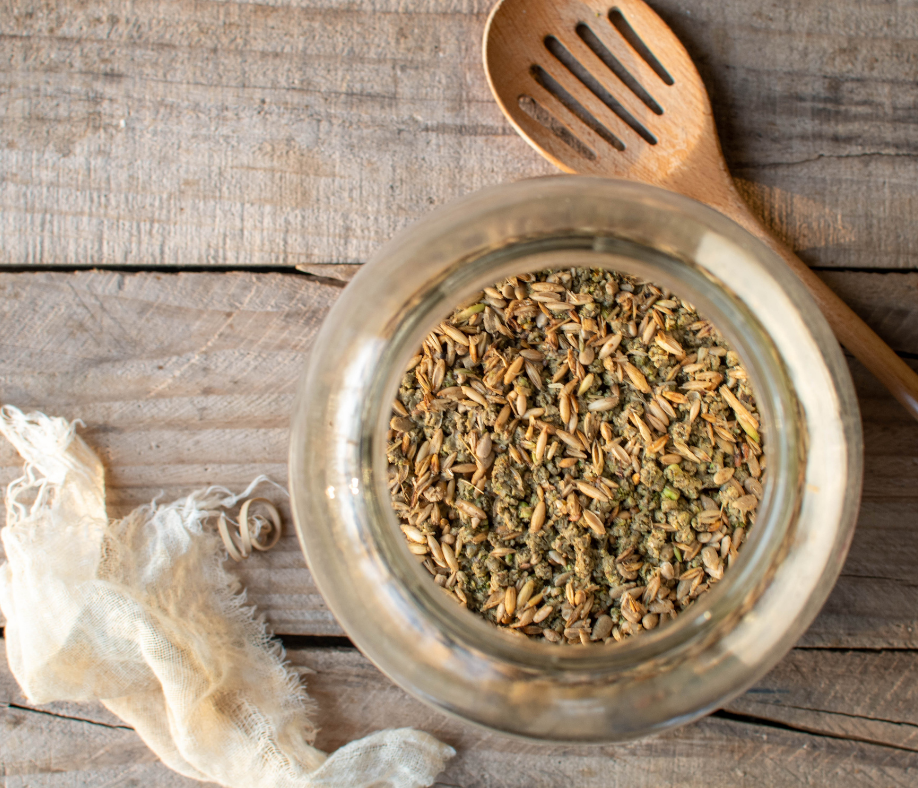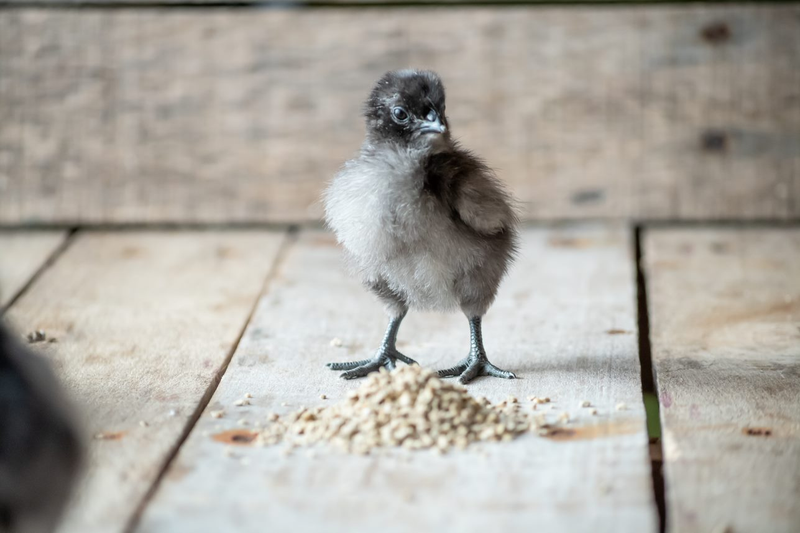Whether you’re transitioning your chicks to their ‘adult food’ or introducing a new food to your flock, it’s important to plan ahead for success. A healthy transition to a layer feed ensures your flock stays healthy and has what they need to lay eggs fit for your family and friends. If your chicks are about to hit the 18-week mark or your ladies are ready to switch to a better diet, all you need is about a week or two and a bit of know-how. This chicken feeding guide will help! We included the information you need to transition your flock to a new diet and some tips and tricks for picky chicks!
This chicken feeding guide includes:
- Changing Your Flock’s Feed At-a-Glance
- How to Transition Your Chickens to New Feed & Snacks
- Why Some Chickens Are Picky
- Issues That Can Occur Due to Picky Eating Habits
- How to Handle Picky Chickens
Changing Your Flock’s Feed At-a-Glance

A quick change in your flock’s feed can result in digestive issues and a higher likelihood of picky-chicken problems. To avoid these issues follow these steps:
Days 1-3: When you first introduce your flock to their new food, dress their current feed with the new feed (in about a 90% to 10% ratio).
Days 4-6: Increase the amount of new food to about 25%.
Days 7-9: Mix your chickens’ food: 50% existing food, 50% new food.
Days 10-12: Increase the ratio of new food to about 75% with the remaining 25% being their former food.
Days 13-14: Increase to a 90% new food to 10% old food balance.
Day 15: Switch to 100% new food on day 15.
How to Gradually Introduce Your Chickens’ New Food

While you may have chickens that eat practically anything, we still recommend gradually introducing and transitioning your feather babies properly to any new foods and feeds.
Gradually Introducing New Food
When it comes to updating your chickens’ diet, slow and steady wins the race. Why? Although feeds are designed and formulated for chickens, no two brands or recipes are alike. There will be differences, even if they’re subtle. These differences can affect your chickens’ behavioral responses, as well as how their digestive systems will react to the new food–yes, poop happens!
Keep in mind that your chickens’ diet is more than just food, it’s part of their routine. Similar to a person cutting out their daily coffee, your girls will experience emotional and physical changes.
So, how do you provide your chickens with a smooth transition to their new food?
Step 1: Evaluate Your Flock’s Current Food
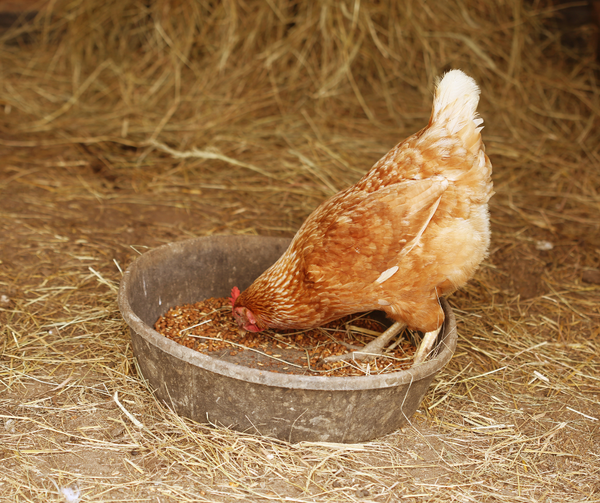
One of the first things to consider if you have picky chickens is to evaluate their food. When evaluating your chicken’s diet, ask yourself:
- Are you providing them with a quality, nutritionally-balanced feed?
- Do they have opportunities to access healthy snacks that they may find naturally if they were to forage, like insects and plants?
- Are you feeding your chickens pellets, crumbles, fermented feed, or mash?
- Is your chickens’ choosiness new?
Domesticated backyard chickens need a quality, well-balanced layer feed with the proper proteins, vitamins, and nutrients, like Grubbly Fresh Pecks.
Deciphering Your Flock’s Nutritional Needs
If you took a closer look at your chicken’s current diet, and it doesn’t provide all the elements they need for a happy healthy life consider if it’s a scratch problem:
Layer Feed vs. Scratch
There are plenty of backyard chicken parents who notice that their chickens will only eat scratch, and leave their regular feed behind. Many of these chicken parents are mixing scratch into their flock's feed on a regular basis. Unfortunately, scratch is not a balanced feed. It’s more like a treat or a light snack to be fed sparingly. Feeding too much scratch will alter the nutritional balance of a regular feed.
Like children, chickens do not always choose the healthy option, so we must encourage our flocks to get the best nutrition they can get.
Newly Picky Chickens
If your chickens have suddenly become picky, it could be an issue of stale food or a change in how or what you’re feeding your flock.
- Freshness: Stale feed will also have lost some of its nutritional quality. Check if you’re storing your flock’s feed in an air-tight, moisture-tight container in a dry, cool location.
- Feeding Patterns: A change in day-to-day routine can disrupt your chicken’s appetites. The root of their pickiness may be due to a change in how you’re feeding your flock, an increase or decrease of scratch or leftovers, or providing too many treats.
Step 2: It Takes Time.
If you are offering your flock a new food they’ve never seen or eaten before, then they need time to adjust. This adjustment period requires a gradual introduction that can be ramped up over the course of the week.
Be patient with your fluffy ones. Your chickens’ will need about two weeks for their digestive systems to adapt to their new food.
Increase New Feed Slowly
- Days 1-3: When you first introduce your flock to new food, dress their current feed with the new feed (in about a 90% to 10% ratio).
- Days 4-6: Increase the amount of new food to about 25%.
- Days 7-9: Mix your chickens’ food: 50% existing food, 50% new food.
- Days 10-12: Increase the ratio of new food to about 75% with the remaining 25% being their former food.
- Days 13-14: Increase to a 90% new food to 10% old food balance.
- Day 15: Switch to 100% new food on day 15.
If your chickens are still hesitant to eat their new food, add a few Grubblies into the mix to make mealtime a bit more exciting.
You can use this same concept for introducing other foods. If your chickens have never had kale before, we suggest chopping it up and sprinkling it on their food or other snacks, as you would with Grubblies.
Step 3: Keep Your Flock Satisfied with Routine
Like other pets, such as cats and dogs, chickens thrive on routine. Additionally, once you find a chicken feed that provides your chickens with complete, balanced nutrition, maintaining a healthy diet is essential.
So, provide your flock with satisfying nutrition that allows your chickens to sustain energy, enrichment, and better eggs. Keep your chickens’ primary diet and feeding routine consistent. Doing so can help you identify health issues such as crop impaction more easily.
A steady diet also allows you more freedom in the fun snacks you feed your flock since you know they’re receiving all the nutrition they need from their primary diet.
Step 4: Mix it Up!
Part of the fun of having your own flock is bringing your chickens joy. Adding snacks into your chickens’ diet can provide them with variety, added nutrition (for better eggs), and help your chickens adopt a more open attitude toward new foods.
Grubblies offer a great opportunity to spoil your chickens with health!
Here are some ideas for Grubbly-based snacks:
- Mix Grubblies with some scratch.
- Scramble some eggs and sprinkle with Grubblies.
- Sprinkle Grubblies on some watermelon or their favorite fruit.
- Toss a handful (or two, or three) into their regular feed.
Step 5: Monitor Your Flock
Monitor your feathered family. This last tip is not just a tip for the introduction and transition of new foods. It’s a tip that we recommend all of the time.
What should you pay attention to?
Observe your chickens’:
- Behaviors
- Eating habits
- Health
- Eggs
- And yes, their poop
A baseline of these behaviors gives you a comparison point to help you more quickly recognize changes that may indicate health issues.
If you Notice Soft Eggs
Even if you feed them a high-quality well-balanced feed, you may have a hen that still lays soft shells. Her genetic code may need more calcium, or may not process calcium as efficiently as her sisters. Then, you can introduce healthy snacks like grubs, which have 50x more calcium than mealworms to help your chicken who is laying soft eggshells.
Monitoring them can also save you money. When your chickens eat “empty calories,” they’ll need more and more of it as their bodies desire more nutrients.
Why Are Some Chickens Picky Eaters?

While many people believe that chickens will eat practically anything, it’s actually common for some chickens to be picky. So, if you have a few fussy eaters in your flock, keep in mind that this is normal. If these fussy eaters are at the top of the pecking order–you may even find that the others will follow their lead--resulting in a number of chickens willing to turn their beaks up at new snacks, treats, and foods.
Younger birds tend to be more finicky, but older birds aren’t exempt from being picky. Pickiness in older chickens is likely a personality trait while younger chickens tend to be more hesitant to try new things due to inexperience and survival instincts.
A Closer Look at How Your Chickens Eat
Unlike people, dogs, and cats, chickens rely less on taste, and more on sight. This is because their taste buds are at the very back of their mouths. So, before they can taste something, they've already committed to swallowing it.
Does flavor matter? Yes. While chickens only have about 350 taste buds, it’s important to keep in mind that chickens have more refined palates than many people once thought. Additionally, chickens develop memories of the food they eat–and individual chickens have unique preferences when it comes to certain foods.
Issues That Can Occur Due to Picky Eating Habits
While picky eating habits may not seem like a big deal, this issue can have a major impact on your hens’ health, your feed cost, and the enjoyment you receive from owning a flock.
Nutritional Deficiencies
First, your chickens’ health depends on them obtaining all of the nutrients their feed has to offer. If your chickens are picking out certain grains while leaving other parts of their feed, they are more likely to develop nutritional deficiencies. This is because your chickens’ feed is balanced as a whole, so every aspect of it provides them with much-needed nutrients.
Trouble Spotting Health Problems
When your chicken won't eat simply because they're picky--it can make spotting other health concerns more difficult. For example, a drop in weight can be caused by a serious health issues such as impacted crop, but if your chickens are picky, this problem could be overlooked.
Food Waste
Additionally, if your chickens refuse to eat part of their feed, their new feed, or healthy snacks, the result is a higher rate of waste. If you find yourself emptying your gals’ feeder of ‘leftovers,’ you’re throwing away money.
Less Flock Enrichment & Owner Enjoyment
Finally, flock owners obtain a great deal of enjoyment from bonding with their chickens by using healthy treats and maintaining a meal-time routine. When your chickens aren’t excited about their snacks–the experience isn’t as rewarding. Additionally, refusal to take snacks can be disheartening and worrisome to backyard chicken owners.
Knowing how to encourage your picky gals is always best for their well-being and your own.
Signs of a Picky Chicken
Often when it comes to a picky chicken, you know one when you see one. However, flock owners with fussy chickens report that their feather babies react as if they’re scared of whatever is being offered to them, whether it’s a grasshopper or some spinach.
This fear of new food for picky chickens can often come in these forms:
- Backing away from the new food (or even running away)
- Responding with suspicion (often observing the food from several angles)
- Vocalizing in a worried manner
- Eventually ignoring the new food
Tips for How to Handle a Picky Chicken
When it comes to choosy chickens, there are some simple ways to encourage them to be more adventurous eaters. Keep in mind that no chicken will change overnight, but over time, you can introduce new foods and snacks with less resistance. Here are some tips that have worked for us:
- Use a feeder or bowl that your flock is used to. This routine and consistency is a great way to introduce new foods as a smaller change in a vessel your gals already trust.
- Introduce new snacks (or feed) mixed into existing favorites and use a little-at-a-time approach.
- Let your more adventurous eaters dive in first. As you likely know, chickens often want what their flock-mates have. This peer pressure can work in your favor when it comes to new snacks.
- Turn new snacks into enrichment games, such as ‘bobbing for grubs.'
Your Chickens Deserve the Best Diet

Graduating your chicks from starter feed to a nutritious and satisfying layer feed is an exciting milestone! Be sure to set your flock up for success with a gradual transition from their existing feed to their new feed and be ready to respond should a few of your fluffy ones exhibit signs of being finicky. Switching from an ordinary flock feed to a higher-quality feed is well worth the time and effort of helping them transition.
When you switch your flock to a feed like Fresh Pecks layer feed, your gals will reward you with beautiful, nutritious eggs with strong shells! And you’ll provide them with the nutrients they need for shiny feathers, bright minds, and well-rounded health.





